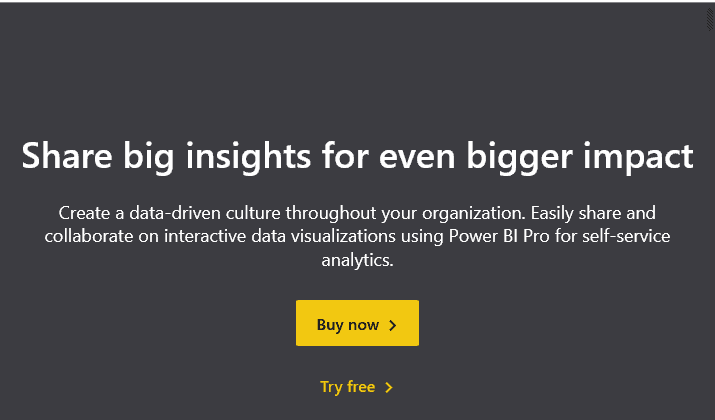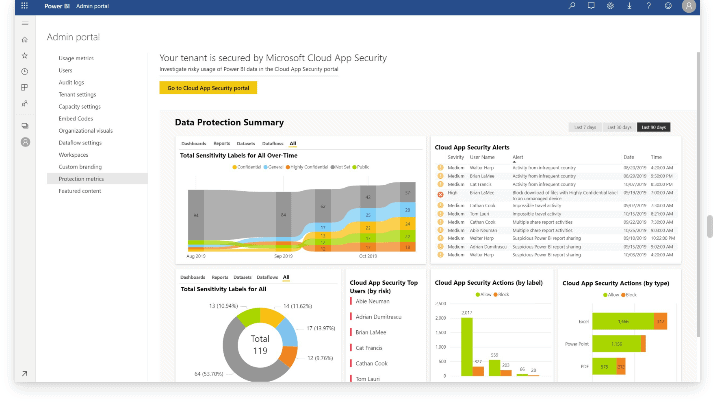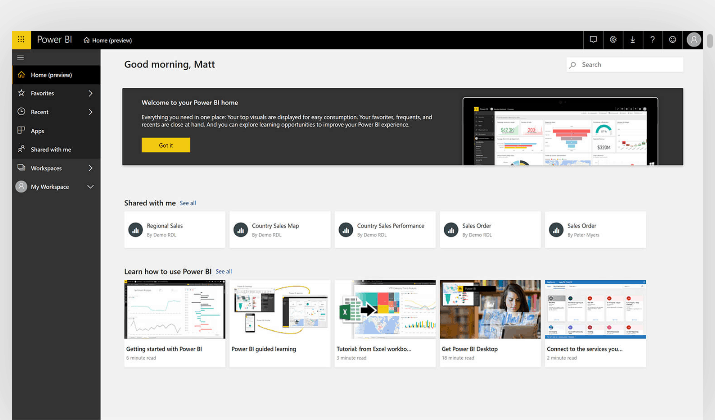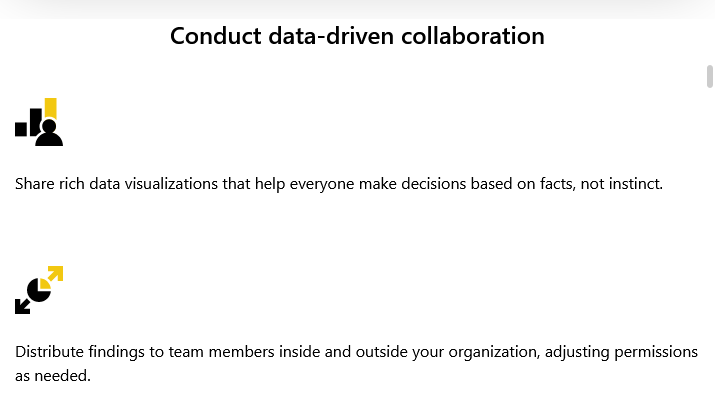Data is what is fuelling today’s modern business. But to make it useful, you have to make sense of it. That can only happen when you have the best business intelligence tool like Microsoft’s Power BI.
Power BI will help you single out valuable, actionable insights from your data and make it work for your business.
In this guide, I will shed light on Microsoft’s popular data analysis tool: Power BI. Specifically, we’ll look at the major differences between Power BI’s Pro version and its Premium version.
Related: 15 Best Power BI Dashboard Examples
But first things first.
- What is Power BI?
- What is Power BI Pro? What is Power BI Premium?
- Power BI Pro vs Premium – What’s the difference?
- Power BI Pro vs Premium – Features
- Power BI Pro vs Premium – Pricing Models
- Power Bi Premium vs Pro: When to Choose What
- Power Bi Pro vs Premium – Pros & Cons
- Power Bi Pro Pros
- Power BI Premium vs Pro: Quick Tabular Glance at the Features
-
Power Bi Pro vs Premium – FAQs
- What’s the Major Difference between Power BI Pro and Power BI Premium?
- How Often Will You Refresh Data on Power Bi Pro?
- How Big Should my PBIX Files be When Using Power BI Premium?
- What is the Price for a Power BI Pro License?
- How Many Users Will I Get When I Purchase a Power BI Premium License?
- How is Data Embedded into Other Applications with Power Bi Pro?
- What Does It Mean By Dedicated Online Processing in Power BI Premium?
- How Does Power BI Pro Leverage Live Data Connections?
- What is a Power BI Report Server License in Power BI Premium?
- How Does Power BI Pro Give Access To The On-Premise Data Gateway?
- How Often Do I Have To Refresh Data on Power BI Premium?
- How is the Online Processing Environment Shared in Power BI Pro?
- Power BI Premium vs Pro: Which Should I Choose?
What is Power BI?

When it’s about self-service data analysis and business analytics, all I can think about is Power BI.
For years, Power BI has proven to be the go-to platform for data analysis, modeling, and reporting.
Any user, skilled or not, can use it to pluck data from disparate cloud and on-premises.
And that’s not all.
From the data collected, you can create reports and build data models enhanced with an array of filters and visualizations.
It also lets you connect with dynamic sources like SQL and Dynamics to form graphs and charts that constantly update data as it streams in.
Power BI started as a free version.
Now there are three versions of the program, including the Power BI Desktop version, Power BI Premium, and Power BI Pro.
In this article, we’ll direct our focus to Power BI Pro and Power BI Premium to understand the difference between these two tiers.
Read on for more.
What is Power BI Pro? What is Power BI Premium?
Power BI Pro

Power BI Pro is Power BI’s full version.
You can use it for dashboard and report building, unlimited viewing, sharing, and consumption of reports (both created and shared).
Power BI Pro license is per user.
With a Power BI Pro license, you can upload up to 10 GB of data to the Power BI Cloud. It also allows you:
- The ability to share dashboards, datasets, and reports with other Power BI Pro users
- To create App workspaces and peer-to-peer sharing
- Local integration with Azure Data Services
- To embed Power BI visuals into apps like PowerApps, Teams, SharePoint, and more
Power BI Premium

Acquiring Power BI Premium allows you exclusive utilization of predetermined computing power.
Besides licensing all users, you’ll also be licensing the capacity of your dashboards, datasets, and reports.
You pay for both space and processing capacity you need to carve out for your business.
It comes with six capacity models with varying memories for you to choose one that you prefer to run your platform.
Premium is designed for enterprise-level businesses that generate large data amounts which require extensive access to the app.
Premium gives you the capacity to process your workloads plus all the necessary infrastructure and Microsoft support.
If you need to create and publish your reports, share your dashboards and collaborate in Power BI workspaces, you’ll need Power BI Premium and a Power BI Pro license.
Interesting Comparison: SAS vs Power BI

But if your goal is to access and consume content, Power BI Premium is enough to do the job.
Power BI Premium allows you:
- Large storage sizes for extensive deployments
- Increased data capacity limits and optimal performance
- Power BI Report Server
- Access to one API surface
- Geo distribution, isolation, read-only replicas, pin to memory, high refresh rates
You also get to store BI assets on-premises and receive a 50 GB cap on dataset size and up to 100 TB data storage.
Power BI Pro vs Premium – What’s the difference?

The difference between Power Bi Pro and Power Bi Premium comes down to performance.
Power BI Pro licenses users individually and allows you to create and consume content at the same time.
As a Pro user, you can connect to hundreds of sources, pull data, create engaging reports, and view 360-degree dashboards.
Most importantly, you’ll be able to share your content with other Pro licensed users and consume their shared content as well.
With Power BI Premium, you purchase a license for your content instead of licensing content users.
Your dashboards, datasets, and reports are stored in premium to be accessed and viewed by countless users at no additional per-user cost.
However, users can only view the content from the dashboards, web reports, mobile apps, or the organization portal/app. They cannot create it.
A content creator in Power BI Premium will need to have a Pro license.
This only means that Power BI Pro is best for you if you want to create and share your content internally.
On the other hand, you should go for Power BI Premium if your interest is to share your content with people outside your organization.
Note that Power BI Pro is inclusive with Office 365 E5 and Microsoft 365 E5 licenses. This is quite helpful, especially when deciphering between Office 365 E3 vs. E5.
Since Power BI Premium licensing is for actual datasets, you can purchase the licenses in different capacity sizes with different virtual cores and numbers of memory.
With time, you can scale as your data analysis requirements change.
You can later upgrade your licenses to accommodate your new power and storage requirements when your datasets grow.
Also Read: Qlik Sense vs Power BI
Power BI Pro vs Premium – Features
Power BI Pro

Power BI Pro is an individually licensed platform that lets you access all capabilities and content in the Power BI service.
So, if you have ten employees and need them to access the full capabilities of Power BI, you’ll have to pay for ten licenses.
Ideally, Power BI Pro is a full-strength Power BI that you can use for building reports and dashboards.
It offers unlimited data report viewing, consumption, and sharing, even those shared by other Pro users.
Features and functionalities of Power BI Pro include:
- Mobile app
- 10 GB storage per user
- Connect to more than 100 data sources
- 8 Data refreshes per day
- Power to embed the visuals in Power BI into apps like SharePoint, PowerApps, and Teams
- AI Visuals
- Embedded controls and APIs
- Create app work and peer to peer sharing
- Local integration with all the other Microsoft solutions
- Data security and encryption
- Share datasets, dashboards, and reports with other Power Bi licensed users
- Metrics with content creation and publishing
Power BI Premium

Power BI Premium is Power BI’s top-tier platform.
It offers on-premises deployment and distribution of reports. This means you can maintain your reports on-premises until you’re ready to move to the cloud.
Power BI Premium is intended to address large enterprise workload and deployment challenges.
Your business can use its dedicated capacity and hardware instead of relying on the shared capacity with Microsoft.
When providing this capacity, you must ensure it’s enough for analysis and reporting.
This will allow you large-scale and enhanced performance if adequately resized.
Microsoft provides three sizes for premium capacity, each with a different number of v-cores and memory size.
Power BI comes with considerably enhanced features and functionalities, including:
- 100 TB storage
- Data flow
- Application lifecycle management
- Geo distribution, read-only replicas, and pin to memory
- Analyze data stored in Azure Data Lake Storage
- 100 GB model size limit
- Access to one API surface
- Power to embed the visuals in Power BI into apps like Teams, SharePoint, and PowerApps
- XMLA endpoint read/write connectivity
- Larger storage size for extended deployment
- 48 daily data refreshes
- Advanced AI features
- On-premise reporting
- Multi-location deployment management
- 400 GB model size limit
- Azure Autoscale add on
Check Out: Tableau vs Power BI
Power BI Pro vs Premium – Pricing Models

Power BI Pro
The Power BI Pro plan is currently going for $9.99 per user per month. This includes data governance, data collaboration, dashboards with a 360-degree view, and the ability to publish your reports anywhere. You’ll find pricing information here.
Power BI Premium
The Power BI Premium plan costs $4,995 a month. Just like Azure, this price scales as your resource requirements increase. The first premium tier ($4,995) is often sufficient for most enterprises.
But if you have a larger organization, Power Bi Premium has other tiers with more resources for a higher cost. You can use the Power Bi calculator to determine the level of premium you need. Check out their pricing models at Power BI’s pricing page.
Power BI Premium Per User
Microsoft came up with a new license structure – Power BI Premium per user for smaller businesses that require premium functionalities without having to pay the $5000 per month minimum price.
This license has most of the premium features except unlimited distribution and multi-geo support.
Table Summary: Power Bi Premium Features Per User & Per Capacity
The license is still under review, and probably some of the details will change. The pricing isn’t finalized too.
| Feature | Power BI Pro | Power BI Premium |
| Licensing | Individual | Content capacity |
| Reporting | Creating & Consumption | Consumption |
| Capabilities in shared capacity workspace | Publish your content to different workspaces. Subscribe to reports and dashboards. Distribute dashboard Share with other licensed Pro users | Publish data to various workspaces Distribute dashboards Subscribe to reports and dashboards Distribute to other licensed Pro users |
| Additional capabilities in premium capacity workspace | Distribute content to users with free licenses | Distribute content to users with free and Pro licenses |
| Data streaming | Unlimited | Unlimited |
| Data refresh frequency | Up to 8 times a day | Up to 48 times a day |
| Space allocation | 10 GB* | 100 TB |
Power Bi Premium vs Pro: When to Choose What
Depending on your organization’s needs, data analysis requirements, and internal expertise, you’ll choose when to implement either the Power BI Pro version or the Power BI Premium version.
When to Get Power BI Pro

Power BI Pro is ideal if you’re a heavy business analytics user using it regularly for creating and consuming data. You’ll also be able to share dashboards, data, and reports with other users.
Your employees in different departments and roles can utilize Pro for dashboard sharing and publishing reports, ad hoc analysis, and analysis collaboration freely.
They’ll be able to publish, share, and export reports for all non-self-service BI users who can access them.
Power BI Pro can deliver maximum business intelligence capabilities for both large and small deployments.
Microsoft is offering a free trial to help you determine whether your business needs more functionalities and if your budget will allow it.
When you have to scale users to data, you’ve got more users viewing your reports than using a self-service BI.
Useful Post: How To Use Power BI On Mac
When to Get Power BI Premium

Power Bi Premium will work well for you if you have a large enterprise that needs many people across the business who’ll be using it to view reports and dashboards.
Power BI Premium will ensure your employees have a license. Apart from high performance, it also supports large data volumes. Your self-service Power BI Pro users will be able to share reports and dashboards freely.
If your business has more than 500 users, Power BI Premium will be a better investment. Your pricing per month will be worthwhile since it will be cheaper on the scale.
Power Bi Pro vs Premium – Pros & Cons
Power Bi Pro Pros

- The power to embed the visuals in Power BI into apps like Teams, SharePoint, PowerApps, etc.
- Create App workspaces and peer-to-peer sharing.
- Local integration with Microsoft solutions like Azure Data Services.
- Share reports securely with other Pro users or place the reports on Premium workspaces for sharing with free license users.
- Share datasets, reports, and dashboards with other Pro licensed users.
Power BI Premium Pros

- Dedicated capacity
- Ease of access for data/report consumers through company portal, mobile apps, and dashboards.
- Capabilities to consolidate both enterprise analytics and self-service analytics solutions.
- Share data with everyone without the need for per-user licenses.
- High scale and performance capabilities – Premium provides dedicated capacity from Microsoft, which ensures dependable, consistent performance. This is unlike shared capacity where workloads run on resources shared between organizations.
- Flexibility to license according to the organization’s capacity.
- High data set refresh frequency.
- It has a Power BI report server.
Also Read: Best Power BI Certification Courses
Power BI Pro Cons
- It’s expensive to purchase individual licensing for all users within the same company.
Power BI Premium Cons
- You aren’t able to manage dashboards or create reports.
- You have to purchase Power BI Pro user licenses separately for users to be able to create reports.
Power BI Premium vs Pro: Quick Tabular Glance at the Features
| Feature | Per User | Per Capacity |
| Model size limit | 10 GB** | 10 GB** |
| Refresh rate | 48/day | 48/day |
| Paginated reports | Yes | Yes |
| Application lifecycle management | Yes | Yes |
| AI capabilities | Yes | Yes |
| Usage-based aggregate optimization | Yes | Yes |
| Advanced dataflows features | Yes | Yes |
| XMLA endpoint connectivity | Yes | Yes |
| Multi-Geo support | No | Yes |
| Enhanced automatic page refresh | Yes | Yes |
| Bring your own key | No | Yes |
| Power BI reports on-premises | No | Yes |
| Unlimited distribution | No | Yes |
Power Bi Pro vs Premium – FAQs
What’s the Major Difference between Power BI Pro and Power BI Premium?
Power BI Pro is an individualized license that lets you access all the content capabilities. In addition, you’ll be able to create and share reports and collaborate with other Pro licensed users.

On the other hand, Power BI Premium supports large data volumes. It also offers the capacity to deliver consistent performance. It enables wide content distribution by Pro users without the need for Pro licenses for content viewers.
How Often Will You Refresh Data on Power Bi Pro?
You can only refresh your data eight times every day when using Power BI Pro.
How Big Should my PBIX Files be When Using Power BI Premium?
The maximum size for my PBIX files is 10 GB on Power BI Premium per PBIX. The maximum total storage is 100 TB.
So, if you have huge amounts of data, Power BI Premium will have the capacity to accommodate your data needs.
What is the Price for a Power BI Pro License?

The price for a Power BI Pro license is $9.95 per month/user. This will give you 10 GB of storage for every licensed user.
With this licensing also comes the ability to share your reports securely across the organization and also collaborate. But each user you share information with should be Pro licensed as well.
Check Out: Best Power BI Books
How Many Users Will I Get When I Purchase a Power BI Premium License?
With a Power BI Premium license, you get an unlimited number of users. In this version, you have no user restrictions because the licensing is per organization.
You’ll also receive perks, including the ability to unlimited report sharing. Here you get to share your reports with users outside the organization too.
How is Data Embedded into Other Applications with Power Bi Pro?
The Power Bi data embedding in Pro is carried out with support from many applications, including Teams, SharePoint, and other SAAS applications.
You can also embed your Power BI reports into your own app using a single-user Power BI license. This will allow you to embed all Power BI capabilities into your application.
What Does It Mean By Dedicated Online Processing in Power BI Premium?

Once you subscribe to Power BI premium, your processing is fully dedicated, meaning that you won’t share your resources with any other organization.
For example, when you upload your PBIX files for processing, they will be handled immediately when received without being placed in a queue. This is vital for many close to real-time data metrics and applications that need monitoring and display.
How Does Power BI Pro Leverage Live Data Connections?
When you have live streaming of data, for example, through IoT devices or telemetry data streaming in from your applications, you are empowered with Power BI to leverage such data and live connections to support your custom datasets and dashboards within the Power Bi platform.
What is a Power BI Report Server License in Power BI Premium?
A Power BI Report Server License is an extension running on top of SQL Server reporting services. It offers you all the abilities of Power BI running within your organization.
This license is a huge value to your business if you want all the processing capabilities of Power BI to run on a secure server in your company.
If you have sensitive data, you want it kept within the confines of your company, and this report server license will guide you on how and where to deploy Power BI.
How Does Power BI Pro Give Access To The On-Premise Data Gateway?
If your data is onsite and you want to sync it with Power BI, you can connect the two through the on-premises data gateway. The data is often stored in a database such as MySQL, Maria, or SQL.
You can install a small piece of software to sync the data to Power BI and make sure you refresh it regularly. You don’t necessarily have to tie the data refreshing machine to Power BI.
How Often Do I Have To Refresh Data on Power BI Premium?
Power BI Premium gives you the ability to refresh your data 48 times per day or once every half an hour.
How is the Online Processing Environment Shared in Power BI Pro?
When you’ve already uploaded your PBIX data file and are waiting for it to be processed in the BI cloud, you’ll be utilizing shared computing power on a hosted cloud server.
This means that your file will be in a queue for processing, which may take little or a lot of time to complete depending on the existing availability.
This is more or less similar to the shared hosting space on the webserver, where resources are shared by all Power BI Pro users.
Explore: Best Power BI Alternatives For Mac
Power BI Premium vs Pro: Which Should I Choose?
If I were to choose between Power Bi Pro and Power BI Premium, I would opt for the premium license because it’s licensed based on content capacity.
Even though I may have to pay more for report creation, dashboard, and data sharing capabilities, subscribing to premium is beneficial in the long run.
This is most especially when my organization will be growing and needing more of the Power BI Premium features like large amounts of space allocation, unlimited data streaming, and more.
With a larger number of users to create reports, my organization will be able to process and make the most out of larger volumes of data.
Using Power BI Pro will be cheaper, with plenty of capabilities and features to utilize for the benefit of the business, including optimal performance and widespread content distribution.
Tom loves to write on technology, e-commerce & internet marketing.
Tom has been a full-time internet marketer for two decades now, earning millions of dollars while living life on his own terms. Along the way, he’s also coached thousands of other people to success.